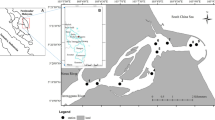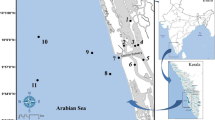Abstract
Polychaete assemblages and associated environment of 12 strategically selected intertidal stations along the extremely polluted Thane creek on the west coast of India were studied monthly for a year and compared with past available data to investigate changes in the creek ecology due to various anthropogenic activities like industrial, domestic, and solid waste disposal along with land reclamation. Shannon’s index (H′) varied spatially from 0.4 to 1.5, Margalef richness index (d) from 0.4 to 1.1, and evenness index (J) from 0.3 to 0.7 indicating poor polychaete diversity. Ceratonereis burmensis and Lycastis indica were the most abundant and omnipresent polychaetes in the creek indicating their tolerance and adaptability to various degrees of pollution. Hydro-sedimentological investigations revealed enhancement of total nitrogen (TN) and organic carbon (Corg) load and hypoxic levels of dissolved oxygen (DO) over the years. Silt component of sediment was increasing, with proportionate decrease in clay due to various anthropogenic disturbances. Species richness was correlated positively with clay and negatively with silt. The BIO-ENV analyses indicated the strong influence of NO3 −-N, clay and TN on the distribution patterns of polychaetes. Pollution-tolerant polychaetes like Lycastis ounaryensis and Polydora tentaculata were getting replaced by more pollution-resistant species like C. burmensis in the creek due to changing sediment texture, reduced oxygen levels, and increased Corg and TN.




Similar content being viewed by others
References
Ajmal Khan S, Murugesan P (2005) Polychaete diversity in Indian estuaries. Indian J Mar Sci 34:114–119
Annie M, Govindan K (1995) Macrobenthos in the nearshore coastal system of Bombay. Proc Natl Acad Sci India 65:411–429
Arasaki E, Muniz P, Pires AMS (2004) A functional analysis of the benthic macrofauna of the Sao Sebastiao Channel (south-eastern Brazil). Mar Ecol (Berl) 25:249–263. doi:10.1111/j.1439-0485.2004.00032.x
Armstrong JW, Jhom RM, Chow KK (1981) Impact of a combined sewer overflow on the abundance, distribution and community structure of subtidal benthos. Mar Environ Res 4:3–23. doi:10.1016/0141-1136(80)90056-2
Athalye RP (1988) Status of macrobenthos in detritus food chain of Thane creek near Thane city. PhD Thesis, University of Bombay, 197 p
Athalye RP, Gokhale KS (1991) Heavy metals in the polychaete Lycastis ouanaryensis from Thane creek, India. Mar Pollut Bull 22:233–236. doi:10.1016/0025-326X(91)90916-G
Belan TA (2003) Marine environmental quality assessment using polychaete taxocene characteristics in Vancouver harbour. Mar Environ Res 57:89–101. doi:10.1016/S0141-1136(03)00062-X
Buchanan JB (1984) Sediment analysis. In: Holme NA, McIntyre AD (eds) Methods for study of marine benthos, 2nd edn. Blackwell Scientific Publications, Oxford, pp 41–65
Cardoso PG, Bankovic M, Raffaelli D, Pardal MA (2006) Polychaete assemblages as indicators of habitat recovery in a temperate estuary under eutrophication. Estuar Coast Shelf Sci 71:301–308. doi:10.1016/j.ecss.2006.08.002
Carpenter S, Caraco NF, Correll DL, Howarth RW, Sharpley AN, Smith VH (1998) Non pollution of surface waters with phosphorous and nitrogen. Issues Ecol 3:1–14
Desai BN, Gajbhiye SN, Ram J (1977) Zooplankton population in the polluted environment off Thana creek-Bombay harbour. Indian J Fish Assoc 7:46–56
FAO (1975) Methods of detection, measurement and monitoring of water pollution. Manual of methods in aquatic environment research, part 1. Food and Agriculture Organisation, Rome, 212 p
Gokhale KS, Athalye RP (1995) Study of impact of pollution on mangrove fauna of Thane creek near Thane city. Report submitted to the Ministry of Environment and Forests, New Delhi, 40 p
Govindan K, Kashinathan R, Desai BN (1976) Quantitative studies on macrobenthic fauna in the polluted Thana Creek and Bombay harbour. J Indian Fish Assoc 6:127–139
Grasshoff K, Ehrhardt M, Kremling K (1999) Methods of seawater analysis. Verlag Chemie, Weinheim, 419 p
Ingole B, Sivadas S, Nanajkar M, Sautya S, Nag A (2008) A comparative study of macrobenthic community from harbours along the central west coast of India. Environ Monit Assess. doi:10.1007/s10661-008-0384-5
Jaiswar ARS, Rokade MA, Zingde MD, Borole DV (2008) Post depositional memory record of mercury in sediment near effluent disposal site of a chlor-alkali plant in Thane creek-Mumbai harbour, India. In: Proceedings of the international symposium on sediment management. Lille, France
Jayraj KA, Sheeba P, Jacob J, Revichandran C, Arun PK, Praseeda KS, Nisha PA, Rasheed KA (2008) Response of infaunal macrobenthos to the sediment granulometry in a tropical continental margin-southwest coast of India. Estuar Coast Shelf Sci 77:743–754. doi:10.1016/j.ecss.2007.11.016
Laponite BE, Clark MW (1992) Nutrient inputs from the water shed and coastal eutrophication in Florida keys. Estuaries 15:465–476. doi:10.2307/1352391
Lu L, Goh BPL, Chou LM (2002) Effects of coastal reclamation on riverine macrobenthic infauna (Sungei Punggol) in Singapore. J Aquat Ecosyst Stress Recovery 9:127–135. doi:10.1023/A:1014483804331
Middleburg JJ, Nieuwenhuize J (2000) Uptake of dissolved inorganic nitrogen in turbid, tidal estuaries. Mar Ecol Prog Ser 192:79–88. doi:10.3354/meps192079
Monserrat JM, Rosa CE, Sandrini JZ, Marins LF, Bianchini A, Geracitano LA (2003) Annelids and nematodes as sentinels of environmental pollution. Comments Toxicol 9:289–301. doi:10.1080/08865140390450386
Nicolaidou A, Pancucci MA, Zenetos A (1989) The impact of dumping coarse metalliferous waste on the benthos in Evoikos Gulf, Greece. Mar Pollut Bull 20:28–33. doi:10.1016/0025-326X(89)90274-9
Park K, Kuo AY, Neilson BJ (1996) A numerical model study of hypoxia in the tidal Rappahannock river of Chesapeake Bay. Estuar Coast Shelf Sci 42:563–581. doi:10.1006/ecss.1996.0037
Parsons TR, Takahashi M, Hargrave B (1984) Benthic communities. In: Biological Oceanographic processes, 3rd edn. Pergamon International Library. Oxford, London, pp 169–256
Patil BM, Shukla VP, Ghosh LK (1997) Mathematical model study for reclamation in Thane creek. Second Indian National Conference on Harbour and Ocean Engineering (Inchoe-97) Thiruvananthapuram, pp 171–181
Quadros G (2001) Study of intertidal fauna of Thane creek. PhD Thesis, University of Mumbai, 264 p
Raman AV, Ganapati PN (1986) Benthic polychaete macrofauna and pollution in Visakhapatnam harbour, India. In: Thompson MF, Sarojini R, Nagabhushnam R (eds) Biology of benthic marine organisms. Oxford, London, pp 463–484
Sahu KC, Bhosale U (1991) Heavy metal pollution around the island city of Bombay, India. Part I: quantification of heavy metal pollution of aquatic sediments and recognition of environmental discriminants. Chem Geol 90:263–283. doi:10.1016/0009-2541(91)90104-Y
Sanders HL, Grassle JF, Hampson GR, Morse LS, Garner Price S, Jones CC (1980) Anatomy of an oil spill: long term effects of the grounding of the barge Florida off West Falmouth, Massachusetts. J Mar Res 38:265–380
Sharma P, Borole DV, Zingde MD (1994) 210Pb based trace element fluxes in the nearshore and estuarine sediments off Bombay, India. Mar Chem 47:227–241. doi:10.1016/0304-4203(94)90022-1
Tiwari LR (1990) Ecological studies on plankton from Dharamtar creek. PhD Thesis, University of Mumbai, 264 p
TMC-ES report (2000) Environmental status report prepared by the pollution control cell of Thane Municipal Corporation, 118 p
Tomassetti P, Porrello S (2005) Polychaetes as indicators of marine fish farm organic enrichment. Aquacult Int 13:109–128. doi:10.1007/s10499-004-9026-2
Varshney PK (1990) Biological productivity of polluted and unpolluted environments of Bombay with special reference to benthos. PhD Thesis, University of Mumbai, 308 p
Walkey A, Black IA (1934) An examination of the Degtjareff method for determining soil organic matter and a proposed modification of the chromic acid titration method. Soil Sci 37:28–30
Zimmerman AR, Canuel EA (2000) A geological record of eutrophication and anoxia in Chesapeake Bay sediments: anthropogenic influence on organic matter composition. Mar Chem 69:117–137. doi:10.1016/S0304-4203(99)00100-0
Acknowledgments
The first and third authors would like to thank MMR-EIS for financial support and Principal, B. N. Bandodkar College for laboratory facilities. This is NIO contribution #4489
Author information
Authors and Affiliations
Corresponding author
Rights and permissions
About this article
Cite this article
Quadros, G., Sukumaran, S. & Athalye, R.P. Impact of the changing ecology on intertidal polychaetes in an anthropogenically stressed tropical creek, India. Aquat Ecol 43, 977–985 (2009). https://doi.org/10.1007/s10452-009-9229-8
Received:
Accepted:
Published:
Issue Date:
DOI: https://doi.org/10.1007/s10452-009-9229-8




